MARK BANDO'S WEBSITE
EAGLE PATCH CORNER
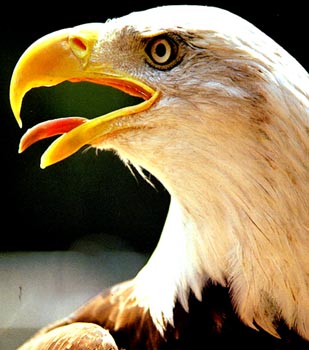 Since 1968, this webmaster has interviewed over 900 WW2 survivors of the 101st ABD, and has paid particular attention to design variances of the eagle patches on their vintage uniforms and in their effects. I've concluded that at least seventeen different WW2 era U.S. made Types exist (with numerous sub-variations made by the same companies), as well as eight British-made designs which have been identified. I have no doubt that there are many more still out there, which I haven't seen. Any visitors to this site, either veterans or patch collectors are encouraged to inform me of any variants of which I'm not aware. If you have a patch of unusual design and think it may be unique or scarce, please let me know about it sooner rather than later, through a scan or snail mail photo.
Since 1968, this webmaster has interviewed over 900 WW2 survivors of the 101st ABD, and has paid particular attention to design variances of the eagle patches on their vintage uniforms and in their effects. I've concluded that at least seventeen different WW2 era U.S. made Types exist (with numerous sub-variations made by the same companies), as well as eight British-made designs which have been identified. I have no doubt that there are many more still out there, which I haven't seen. Any visitors to this site, either veterans or patch collectors are encouraged to inform me of any variants of which I'm not aware. If you have a patch of unusual design and think it may be unique or scarce, please let me know about it sooner rather than later, through a scan or snail mail photo.
Much confusion exists among collectors as to what time periods a particular design dates to. This is compounded by the fact that some WW2 era Types were left over after that war ended, and in some cases were still in use as late as the Vietnam War. In the case of those few Types, there is little or no physical difference, and only provenance (i.e. who it came from, and when he served)can place the approximate time of manufacture. I believe that the manufacturer of Type 10 only started making them near the end of WW2. Hence, WW2 worn examples are relatively scarce, yet the total number produced by that company up until 1965 was relatively great. Patches of that Type were heavily used at Ft Campbell in the late 1950's to early 1960's but had mostly faded out by the time the First Brigade was joined in Vietnam by the rest of the division in 1967. No other 101st patch which originated in WW2 had such a long lifespan. Also remember that WW2 vets who continued as career soldiers sometimes wore WW2 vintage eagle patches on their right (former unit)shoulders as late as the early 1970's.
I feel that my particular type of research (I was already a collector when I embarked on this), combined with the length of time spent- and the quantity of veterans contacted, makes me uniquely qualified to devise a numbering system. With this, we can bring at least some order out of chaotic confusion. This will help collectors better recognize the design permutations of the most famous of all shoulder insignia in the U.S. Army. Anyone who feels better-qualified than me to do this is welcome to offer an alternative identification system. My numbering system is quite simple. Type 1 is the most common, and increasing rarity corresponds with increasingly higher numbers. Again, this opinion as to relative scarcity is based on my observations, not only at Reunions and in veterans' homes, but at collector shows as well.
I would also point out that all of the U.S. variants numbering higher than ten seem to be of similar scarcity, making it difficult to decide precisely in which order they should be labeled. I welcome corrections and divergent opinions, in the interest of further improving our general knowledge of the subject. I wrote an illustrated article on this subject for several years in The Screaming Eagle, the magazine of the 101st Airborne Division Association. Those who can avail themselves of back issues of that publication will find detailed descriptions of the first 15 U.S. Types, as well as images of same and photos of them in wear during WW2. Some of the higher-numbered Types have since been re-numbered and this is still subject to further revision as more
information surfaces. I hope to eventually repeat all of the info given in the SE articles and more on this page.
Some patch collectors are probably saying, "Hell, I've got 40 WW2 variants of the 101st patch!". I would ask them to consider this: I only assign a Type and number to distinctly different variations. Consider that under my numbering system, there are four sub-variants of Type 1-each identifiable as that Type, yet recognizably different IN SOME DETAILS. Type 3 has at least two sub variations, Type 4 has several, Type 5 has at least three subs variants, Type 6 has at least six sub variations, Type 7 has two, etc. So, where some might see twenty variants, I would consider them seven true variants (Types), with the rest being spinoffs, with minor detail differences, yet still of those seven basic Types. Even the higher numbered patches exist in sub variations, but usually, if I believe that a patch has enough in common with a certain Type, that it was made by the same manufacturer, it gets labeled as a sub-variant rather than as a distinct Type. By the way, these variations have no real significance. Each government contractor had their own artists and their own resulting design.
Most sub-variants represent quirks by the workers which resulted in slight differences in various 'runs', possible shortages of particular materials, or outright defects or mistakes made by individual workers. If this is the case, why bother to categorize these patches at all? There are at least two answers to that question. First, it is interesting to know which of all the patches floating around in collections can definitely be attributed to the WW2 era. If this info is not recorded soon, it will be lost forever. Secondly, it is interesting to realize just how many different companies were engaged in making the same basic product for the U.S. government. After determining relative scarcity, we can surmise which patches were manufactured in large quantities and which in increasingly smaller amounts. Of the first nine variants shown below, it is my belief that manufacture of all of them stopped in 1945, so they are totally of the WW2 era. Leftovers may have been used in the early 1950's when the eagle patch-minus Airborne tab-was worn by Basic Trainees at Camp Breckinridge, KY. That useage so-incensed WW2 veterans of the 101 that they started a letter writing campaign to Washington to have it stopped. Less than five years later, in 1956, the 101st Airborne was reactivated as a full-blown Airborne Division and has been in existence ever since. Once again, surplus stocks of leftover WW2 vintage patches may have been issued post-1956, until used-up. The subject of novelty patches and oddballs will be addressed seperately in the future. Enough of this confusion! The following is a scan of the nine most commonly encountered WW2 U.S. made 101st Airborne SSI. We can also assume that they were manufactured in the largest numbers as well.

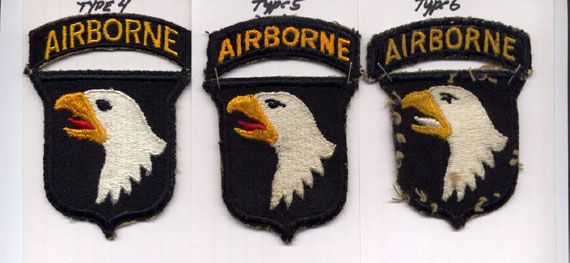
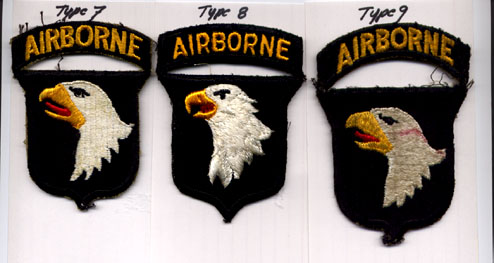 Each of the patches depicted above has WW2 era provenance and is named to a
101st Airborne veteran. Some observations about the nine most common WW2 U.S. made variants shown above: Of the nine, only three were made with integral (attached) Airborne tabs, Types 3,7, and 8. Types 1 and 2 have almost identical detailed eyes and were possibly made by the same manufacturer, yet are distinctly different. Type 2 had a sharper beak, wider shield, and was issued with a narrower
tab. Type 3 and 4 both feature similar "amoeba-shaped eyes", with no detail. The main difference is that Type 3 has an attached tab and Type 4 has a seperate Airborne tab. I call Type 5 the "line and dot eye". Sub-variants exist, with a less distinct forehead between the beak and eye, and a white-tongued sub variant of Type 5 also exists. Type 6 is characterized by a star-shaped or asterik-shaped eye. At least 7 sub-variants of this Type exist, including size differences, a red-tongued version, a white tongued version with green finish on reverse, a sub-variant with no seperation between tab and shield (of uniform thickness throughout), and a small version with round-domed head. Type 6's have the asterisk-shaped eye in common.
Each of the patches depicted above has WW2 era provenance and is named to a
101st Airborne veteran. Some observations about the nine most common WW2 U.S. made variants shown above: Of the nine, only three were made with integral (attached) Airborne tabs, Types 3,7, and 8. Types 1 and 2 have almost identical detailed eyes and were possibly made by the same manufacturer, yet are distinctly different. Type 2 had a sharper beak, wider shield, and was issued with a narrower
tab. Type 3 and 4 both feature similar "amoeba-shaped eyes", with no detail. The main difference is that Type 3 has an attached tab and Type 4 has a seperate Airborne tab. I call Type 5 the "line and dot eye". Sub-variants exist, with a less distinct forehead between the beak and eye, and a white-tongued sub variant of Type 5 also exists. Type 6 is characterized by a star-shaped or asterik-shaped eye. At least 7 sub-variants of this Type exist, including size differences, a red-tongued version, a white tongued version with green finish on reverse, a sub-variant with no seperation between tab and shield (of uniform thickness throughout), and a small version with round-domed head. Type 6's have the asterisk-shaped eye in common.
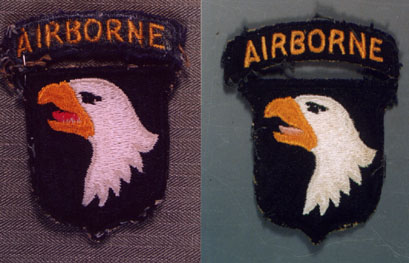 A number of patches like the 2 above, have surfaced with Gary Dettore's 321st GFAB research. The only other one I've seen, came from a 907th GFAB man. I considered giving these a whole new Type category, but upon making comparisons, I suspect these are yet another sub variant of Type 6. The eye on these has a ramp, similar to Type 9, however, the top line of the eye does not curve upward toward the left (front) of the eagle's face. Instead, the top line curves downward at the left end. Both eyes also feature a small 'corner' to the top line at the rear (right) end of that top line. It looks like the asterisk was not completed when rendering these eyes. Also, the patches share other characteristics of Type 6 patches. The eagle's head shape on the left example is so similar to Type 4's, that it makes me wonder if the same company made both Type 4's and Type 6's, with just a design difference in the 2 patterns?
A number of patches like the 2 above, have surfaced with Gary Dettore's 321st GFAB research. The only other one I've seen, came from a 907th GFAB man. I considered giving these a whole new Type category, but upon making comparisons, I suspect these are yet another sub variant of Type 6. The eye on these has a ramp, similar to Type 9, however, the top line of the eye does not curve upward toward the left (front) of the eagle's face. Instead, the top line curves downward at the left end. Both eyes also feature a small 'corner' to the top line at the rear (right) end of that top line. It looks like the asterisk was not completed when rendering these eyes. Also, the patches share other characteristics of Type 6 patches. The eagle's head shape on the left example is so similar to Type 4's, that it makes me wonder if the same company made both Type 4's and Type 6's, with just a design difference in the 2 patterns?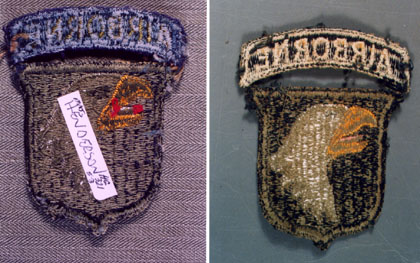 Here's the reverse of the 2 patches shown above. The one at left (from Major Henderson, the S-3 of the 321st), has a green finish on the reverse of the shield-the tab is probably a period mismatch. The specimen at right is almost identical, down to the green finish, but features a PINK tongue. It is NOT a white tongue colored with a red pen and since faded out to pink. The clean thread is still pink on both sides. I suspect these patches were made 'early' (circa 1942).
Here's the reverse of the 2 patches shown above. The one at left (from Major Henderson, the S-3 of the 321st), has a green finish on the reverse of the shield-the tab is probably a period mismatch. The specimen at right is almost identical, down to the green finish, but features a PINK tongue. It is NOT a white tongue colored with a red pen and since faded out to pink. The clean thread is still pink on both sides. I suspect these patches were made 'early' (circa 1942).
Type 7 is one of the most attractive U.S. made Types, with one version having obvious parallel vertical ripples in the white portion of the bird's head and neck. These ripples are less-pronounced on some, but all Type 7's have an attached Airborne tab. There is a pronounced crimp in the beak, where it meets the forehead, and the gold AIRBORNE letters fill the tab almost to overflowing.
I call type 8 the 'seagull head' patch as the bird has a small head and beak. The Airborne tab is integral and the base material is black velvet, with the bird embroidered in cotton thread. The feathers are 3 dimensional, thick, and padded. These were long (incorrectly) believed to be Theatre-Made. (see page 2).The only sub variations I've seen in these is the shade of thread used to render the beak and lettering, ranging from pale yellow to bright gold. Type 9 is a large patch, characterized mainly by the upper line of the eye, which sweeps upward at the front. Sub-variants differ mainly in the size of the bird and the total size of the tab and shield.
Type 8
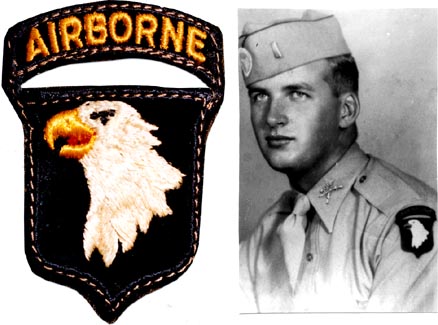 The man behind the patch. Lt Tom Kennedy procured Type 8, characterized by a small head and beak and thick padded feathers on a black velvet base. This was arranged in 1943, with a N.Y. patch manufacturer who delivered enough for each officer in the 101st to receive two. Purpose was to use them on Class 'A' dress uniforms. EMs received some of the leftovers. The 501 was not yet part of the 101st Division and I've never seen one in the effects of a 501 vet. These were NOT theatre-made as the photo above proves. This depicts Lt Kennedy of G/506th, at Ft Bragg, N.C., wearing the Type 8 patch in 1943, before the division sailed to England. This patch has an attached tab and sub variations seem limited to varying shades of yellow to gold thread used in construction of the beak. Scarcity rating of Type 8 patches:"Moderately Rare". These types are seldom offered for sale, not because of their rarity but because a lot of people want to keep them.
The man behind the patch. Lt Tom Kennedy procured Type 8, characterized by a small head and beak and thick padded feathers on a black velvet base. This was arranged in 1943, with a N.Y. patch manufacturer who delivered enough for each officer in the 101st to receive two. Purpose was to use them on Class 'A' dress uniforms. EMs received some of the leftovers. The 501 was not yet part of the 101st Division and I've never seen one in the effects of a 501 vet. These were NOT theatre-made as the photo above proves. This depicts Lt Kennedy of G/506th, at Ft Bragg, N.C., wearing the Type 8 patch in 1943, before the division sailed to England. This patch has an attached tab and sub variations seem limited to varying shades of yellow to gold thread used in construction of the beak. Scarcity rating of Type 8 patches:"Moderately Rare". These types are seldom offered for sale, not because of their rarity but because a lot of people want to keep them.
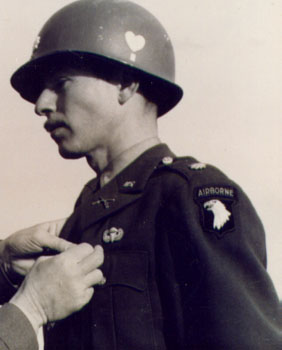 Of all the wartime photos I've seen showing Type 8 in wear, this one is the best and clearest closeup. Major Tom Sutliffe of CT variously served as XO of 1st and 2nd battalions of the 502 PIR. He was evacuated toward the end of the Bastogne campaign while serving as 2nd Bn XO, for severe back pain. Some thought he was malingering to get out of combat. He was sent to a hospital in Paris, where it was discovered that he had a rare disease. He died at a hospital back in the U.S. in May, 1945. In this photo, Sutliffe was being decorated by General Anthony McAuliffe.
Of all the wartime photos I've seen showing Type 8 in wear, this one is the best and clearest closeup. Major Tom Sutliffe of CT variously served as XO of 1st and 2nd battalions of the 502 PIR. He was evacuated toward the end of the Bastogne campaign while serving as 2nd Bn XO, for severe back pain. Some thought he was malingering to get out of combat. He was sent to a hospital in Paris, where it was discovered that he had a rare disease. He died at a hospital back in the U.S. in May, 1945. In this photo, Sutliffe was being decorated by General Anthony McAuliffe.
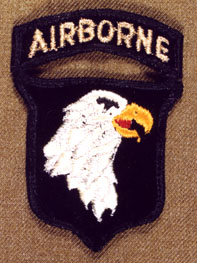 In September, 2002, 2 examples of a reversed Type 8 surfaced in the effects of the late Lt. J.W.King formerly 3/506th S-4. These are exactly like regular Type 8's but the eagle faces to the right for wear on the former unit shoulder. Also, the AIRBORNE letters are threaded over with a gilt colored thread, and silver wire hightlights are added to the neck feathers of the eagle. This mirror image patch is also on a velvet base. This suggests that the N.Y. manufacturer of Type 8 continued to make a finite quantity like these, circa 1945, for returning combat survivors of the 101 to wear during continued service in the postwar Army.
In September, 2002, 2 examples of a reversed Type 8 surfaced in the effects of the late Lt. J.W.King formerly 3/506th S-4. These are exactly like regular Type 8's but the eagle faces to the right for wear on the former unit shoulder. Also, the AIRBORNE letters are threaded over with a gilt colored thread, and silver wire hightlights are added to the neck feathers of the eagle. This mirror image patch is also on a velvet base. This suggests that the N.Y. manufacturer of Type 8 continued to make a finite quantity like these, circa 1945, for returning combat survivors of the 101 to wear during continued service in the postwar Army.
Kennedy was a member of the new 101st Division in 1956, and gave a WW2 Type 8 patch to an insignia salesman from the Ft Campbell area, asking him to duplicate it. The resulting patches are pictured below. Velvet Patches 1956-75
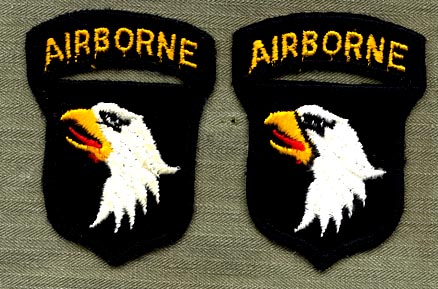 THESE ARE NOT WW2 ERA PATCHES!!! The first type, at left (2,000 were made, according to to Kennedy), has no black line seperating the beak from the face of the bird. Probably no more than the original 2,000 of the first type were made. The second type(2,500 made in the first batch,)does. These patches with the black seperating line are far more numerous than the first type, and were probably manufactured for about 20 years, until the mid 1970's. Both of these are post-1956 variants, despite similarities to old Type 8 of attached tab, velvet base, and padded feathers. Many of these show-up on Vietnam era class'A' green jackets. Of the initial period in 1956, Kennedy writes: "The units purchased them from the HQ Comdt. office for resale to the troops at about $1.50 apiece. There was a complaint from the P.X. officer, resulting in the patches being stocked and sold in the P.X.-to the best of my failing memory."
THESE ARE NOT WW2 ERA PATCHES!!! The first type, at left (2,000 were made, according to to Kennedy), has no black line seperating the beak from the face of the bird. Probably no more than the original 2,000 of the first type were made. The second type(2,500 made in the first batch,)does. These patches with the black seperating line are far more numerous than the first type, and were probably manufactured for about 20 years, until the mid 1970's. Both of these are post-1956 variants, despite similarities to old Type 8 of attached tab, velvet base, and padded feathers. Many of these show-up on Vietnam era class'A' green jackets. Of the initial period in 1956, Kennedy writes: "The units purchased them from the HQ Comdt. office for resale to the troops at about $1.50 apiece. There was a complaint from the P.X. officer, resulting in the patches being stocked and sold in the P.X.-to the best of my failing memory."
A French book entitled "L'Epopee de la 101st Airborne", published by Regi Arms, Paris, 2002, used some photos which they only could have gotten from my books, but did not mention me nor credit my books. They also used these Ft. Campbell era velvet patches on the front and back cover of that publication, furthering the myth that these are WW2 era patches.
Type 9 Variants
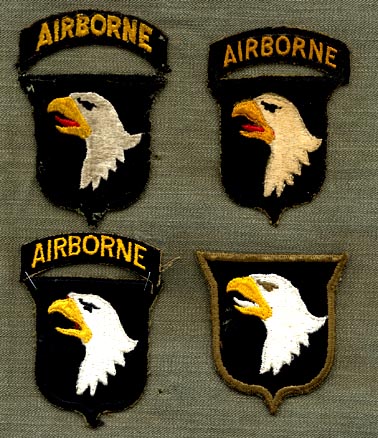 Type 9, characterized by the upper line of the eye, which curves upward toward the front of the face, is usually
larger than other eagle patches in overall size. This means the shield is wider across the top, and the Airborne tab is correspondingly longer to match it. The basic Type 9 at upper left came from Lt Matson of H/502. All Type 9's have a ramp- shaped eye, with no detail in it, below the upper line. I've seen numerous sub-variants of this, beyond the few examples depicted above. The patch at top right comes from Lt Gordon Deramus of the 502, and has a rounder head and less pronounced uplift at the front of the eye. The example at lower left is not only different in some details, but also clearly a factory defect, as the tongue was never added. This comes from LTC Ben Weisberg of the 377th PFA Bn. The famous "O.D. border" variant at lower right, I've concluded, was made in 1942 by the same company that made the more common Type 9's. Little is known about the O.D. border patch. When I refer to it as 'famous' I mean to patch collectors. Among 101st veterans, it seems almost unknown. The example shown has a white tongue, an O.D. eye, and it is always encountered without an Airborne tab. This patch is also of notably thicker construction than most 101st patches. The overall size and design of the bird, plus the uplifted eye suggest its relationship to the other Type 9's. I might add that I've never seen one of these in the hands of a WW2 101st vet. My specimen comes from patch authority Bruce Brooks of ASMIC. I've long speculated that these patches existed 'early' in the 101st's history, and weren't around for long.
Type 9, characterized by the upper line of the eye, which curves upward toward the front of the face, is usually
larger than other eagle patches in overall size. This means the shield is wider across the top, and the Airborne tab is correspondingly longer to match it. The basic Type 9 at upper left came from Lt Matson of H/502. All Type 9's have a ramp- shaped eye, with no detail in it, below the upper line. I've seen numerous sub-variants of this, beyond the few examples depicted above. The patch at top right comes from Lt Gordon Deramus of the 502, and has a rounder head and less pronounced uplift at the front of the eye. The example at lower left is not only different in some details, but also clearly a factory defect, as the tongue was never added. This comes from LTC Ben Weisberg of the 377th PFA Bn. The famous "O.D. border" variant at lower right, I've concluded, was made in 1942 by the same company that made the more common Type 9's. Little is known about the O.D. border patch. When I refer to it as 'famous' I mean to patch collectors. Among 101st veterans, it seems almost unknown. The example shown has a white tongue, an O.D. eye, and it is always encountered without an Airborne tab. This patch is also of notably thicker construction than most 101st patches. The overall size and design of the bird, plus the uplifted eye suggest its relationship to the other Type 9's. I might add that I've never seen one of these in the hands of a WW2 101st vet. My specimen comes from patch authority Bruce Brooks of ASMIC. I've long speculated that these patches existed 'early' in the 101st's history, and weren't around for long.
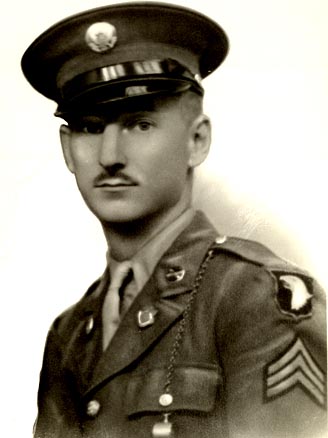 The photo above, dug-up by Gary Dettore in his 321st research, is the only vintage photo I've ever seen of the O.D. bordered patch being worn. Sgt Nelson Kopacka of the 321st GFA Bn was photographed wearing this one in 1942, around the time the newly-activated 101st Division left Camp Claiborne, LA to move to Ft Bragg N.C. Note the absence of an Airborne tab in the photo. Later on, 101st troops seldom wore garrison caps as shown, using overseas caps almost exclusively. A close look at the Kopacka photo indicates that the patch has a red tongue, unlike the usually seen version depicted above. One of those red tongued specimens was sold on E Bay in 2003. It was paired with an Airborne tab that was intended for use with another type patch and the tab had no OD border.
The photo above, dug-up by Gary Dettore in his 321st research, is the only vintage photo I've ever seen of the O.D. bordered patch being worn. Sgt Nelson Kopacka of the 321st GFA Bn was photographed wearing this one in 1942, around the time the newly-activated 101st Division left Camp Claiborne, LA to move to Ft Bragg N.C. Note the absence of an Airborne tab in the photo. Later on, 101st troops seldom wore garrison caps as shown, using overseas caps almost exclusively. A close look at the Kopacka photo indicates that the patch has a red tongue, unlike the usually seen version depicted above. One of those red tongued specimens was sold on E Bay in 2003. It was paired with an Airborne tab that was intended for use with another type patch and the tab had no OD border.
Kopacka is also wearing the Tiger Paws D.I. of the 321st on his lapels. courtesy G. Dettore.
A type 10 scribble eye patch with OD border exists, but info from Allan Henderson indicates that a batch of those were altered(faked) by a repro artist with a sewing machine, less than 20 years ago.
* Note: When you observe any patches on these pages having the Airborne tab stapled to the shield, it can be assumed that the patch was made with a seperate tab. I do this to keep tabs and shields in my collection from getting mixed-up and seperated.-M.B.















